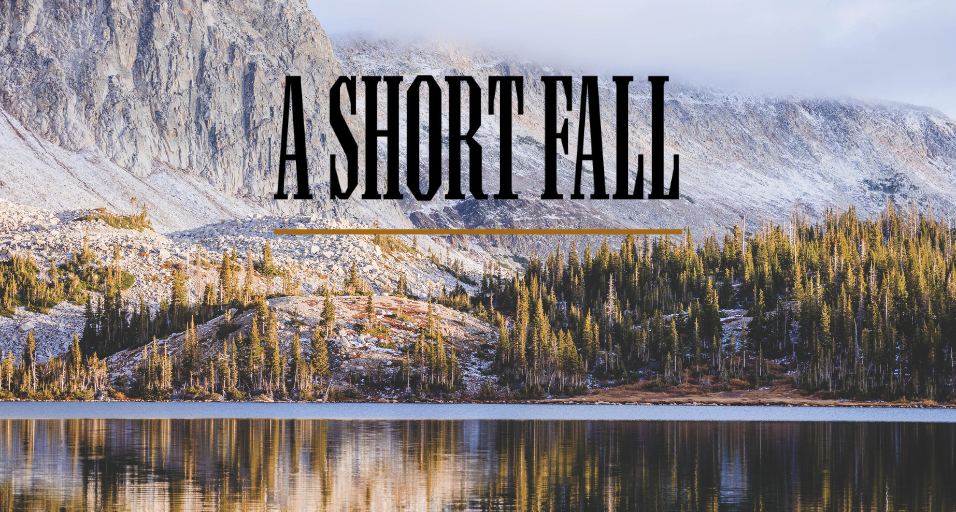When it comes to Wyoming’s wildlife and open spaces, the one constant is they are special. Whenever and wherever you see wildlife, it is a unique opportunity. To some, it’s an opportunity of a lifetime. When you see these critters and their environments in the fall, it’s often an exceptional experience. Whether it is mule deer or other big game in the rut, migrating birds or fish preparing to spawn, there is something special about seeing wildlife in the fall. And, it is hard to beat viewing the changing of colors along the landscape throughout Wyoming. It may not last long, but can be spectacular when this transition occurs. Fall comes with a familiar feel of something new. You can see the familiar and iconic wildlife and landscapes but transformed through the changing season. Wyoming Game and Fish Department employees shared their best and favorite fall photos with Wyoming Wildlife. The 13 photos selected came from more than 150 submitted. Narrowing it down to 13 was difficult — but fun. A special thank you to all the Game and Fish employees who participated in this endeavor.
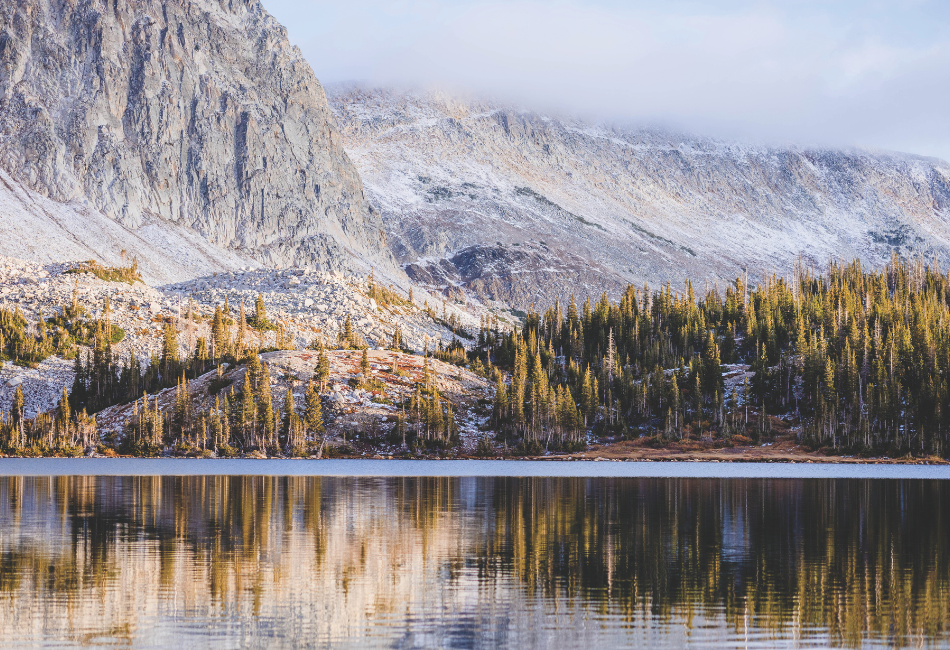
Lake Marie Landscape - Emalee Smith, marketing/media specialist, Cheyenne
Fall in Wyoming offers a unique and captivating experience, distinct from the typical vibrant season many envision. Its individualistic charm presents a mix of differing days and subtle transformations. On a refreshing, October morning, I embarked on a fall fishing photo project in the Snowy Range with some coworkers. We started at Lake Marie, nestled within the Medicine Bow-Routt National Forest. Our primary goal was to capture angler enjoyment in autumn through photographs. Upon our arrival, I sought the perfect lighting conditions for our shoot. As the sun gradually wove through the trees behind us, it cast a glow over the landscape featured in the photo. Observing the sunlight falling on the hills, I admired the serene ambiance of our surroundings. This awe-inspiring moment deepened my appreciation for the breathtaking landscape we aimed to capture, reminding me of the unique allure of fall in Wyoming.
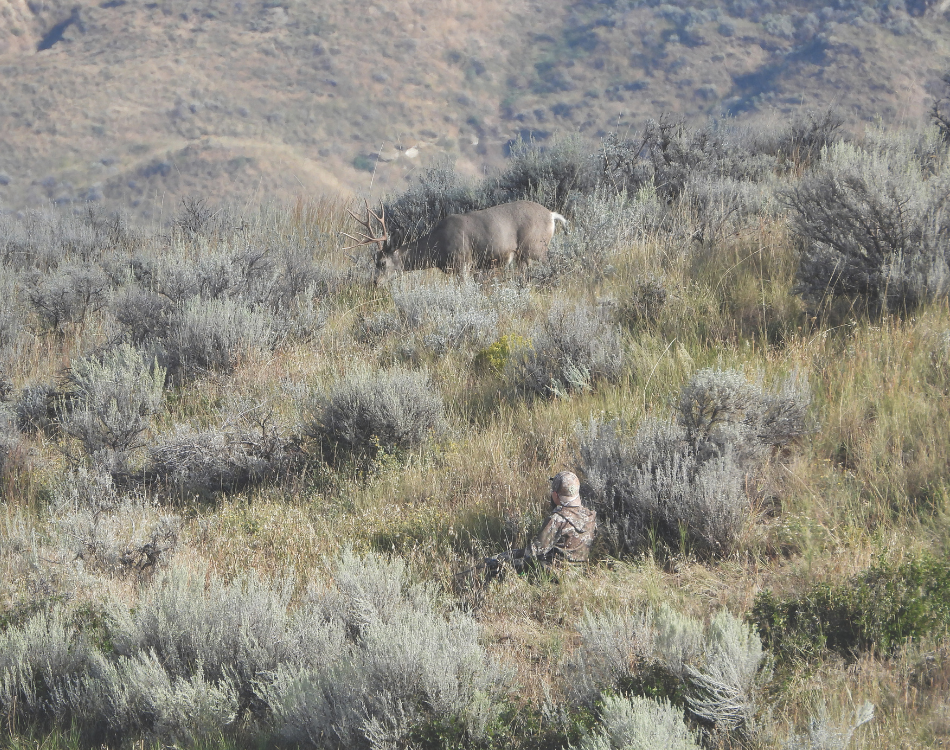
Dawson's Hunt - The photo was taken by a Game and Fish employee who requested not to be identified.
On his 12th birthday, Dawson informed his parents he wanted to begin his big game hunting career by attempting archery mule deer hunting in a general hunt area in open sagebrush. When informed of the patience and skill required to pull off such a harvest, Dawson took it as a challenge. During the archery season and when his sports schedule allowed, Dawson and his parents found bedded mule deer bucks in open country and strategized stalking techniques and how to read the wind. Dawson soon learned the sting of a long but failed stalk, but he shook off the repeated failures and was determined to keep hunting. In one instance he patiently waited for a buck to stand up for more than four hours while seated 30 yards away. The buck finally stood but immediately started walking away from Dawson and his drawn bow. Dawson let down his bow and watched the buck walk away like a seasoned hunter. The photo is a bit of an illusion as the topography did not allow Dawson to see the deer, and the deer seemingly did not see or smell Dawson because it slowly walked away shortly after this photo was taken.
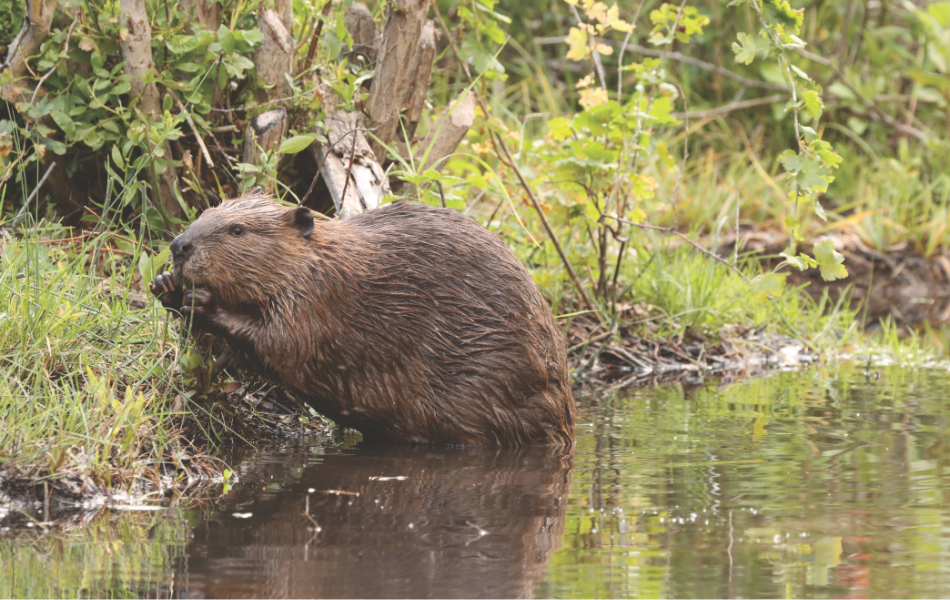
Busy Beaver - Amy Anderson, habitat biologist, Lander
If you’ve never taken an hour to sit quietly beside a beaver pond at dusk, it is an experience I highly recommend. The peacefulness as nature closes in around you is well worth the wait. In this photo, a female beaver forages on horsetail, sedges and rushes while damselflies skim the water surface. A yellow warbler calls sweetly from the aspen trees nearby. A doe mule deer and her fawn come slowly to the water for a drink, and a dusky grouse peers down from the densely wooded hillside. Beavers are of particular interest to me because of the benefits they provide by keeping water on the landscape to grow healthy, riparian forage for mule deer, moose and other wildlife. This busy beaver was working hard to provide for her kits, and caching the willow and aspen stems you can see cut nearby in the mud below her lodge to feed through the winter. Beaver are one of the many interesting wildlife watching opportunities on Green Mountain, south of Jeffrey City.
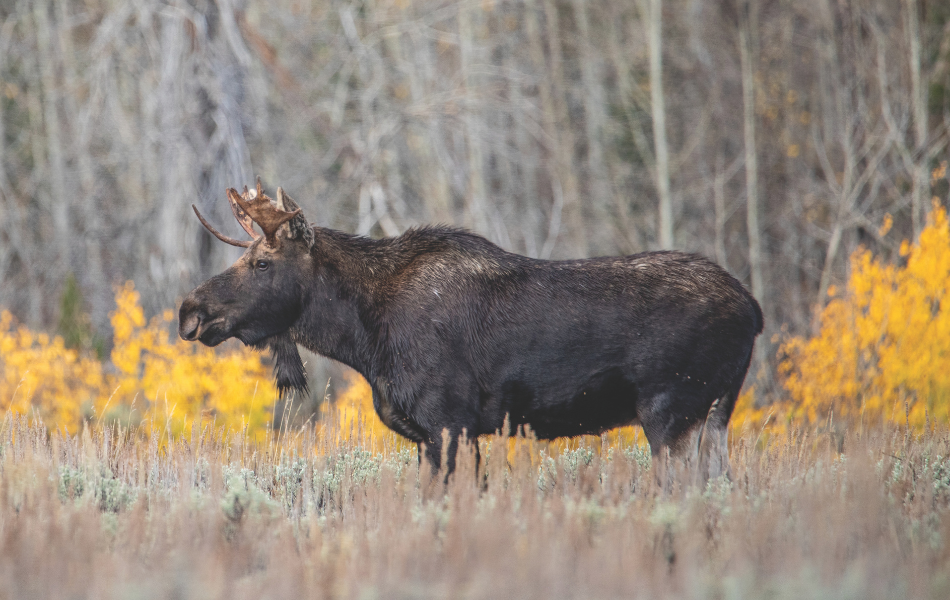
Bull Moose - Patrick Owen, visual information specialist, Cheyenne
While on assignment last fall in Grand Teton National Park to capture photos of elk in rut, I came across this bull moose. He was alone and actively grazing in a lush field of sagebrush and other native plants — with a backdrop of beautiful fall foliage. Although he was impressively large, his paddles were small but unique. Ray Hageman, Game and Fish senior multimedia specialist, and I captured photos and video of him for quite some time until he moved directly toward us. He then took a sharp turn across the dirt road we were parked on and sprinted into the distance. This photo trip remains one of my favorite assignments while working for the department. Earlier that morning, we photographed dozens of elk in rut and five otters eating large fish on the bank of the Snake River near Oxbow Bend. Shortly after our young moose encounter, we photographed a red fox actively hunting for small rodents next to the parking lot at Jackson Lake Lodge.
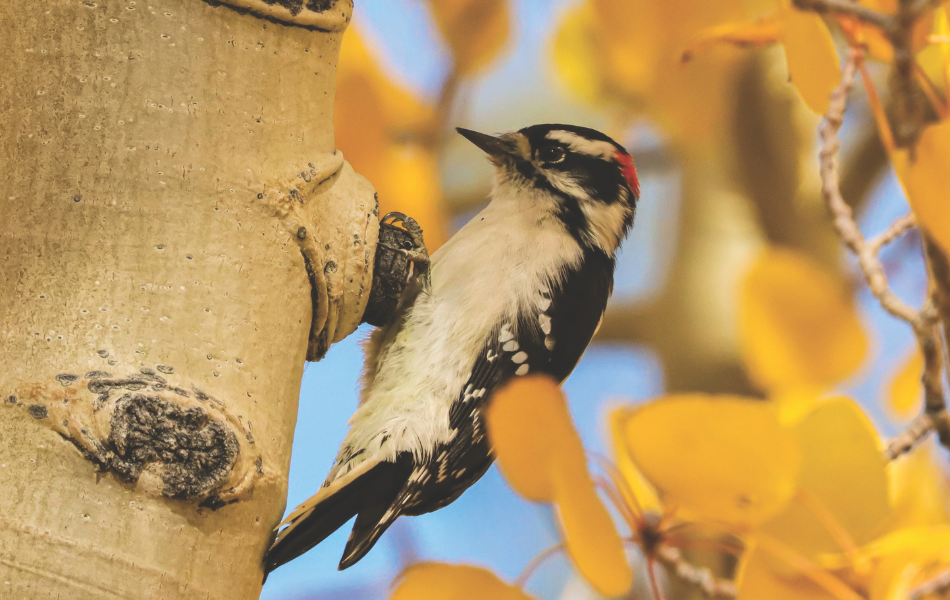
Downy Woodpecker - Amy Anderson, habitat biologist, Lander
As the habitat biologist for the Lander Region, I have the pleasure of spending a lot of time in aspen communities. Aspen communities in the fall are one of the most beautiful and busy places to be for wildlife in Wyoming. Mule deer are munching on aspen stems and leaves, making their last push to fatten up ahead of winter. Chipmunks and golden-mantled ground squirrels scamper in the understory, cheeks full of seeds and nuts trying to cache their winter food supply. Many species of birds are foraging, preparing for their long fall migrations. This male downy woodpecker was tapping out a cadence and looking for insects as I walked through an aspen stand on South Pass where a saw crew recently cut conifer trees in order to stimulate aspen sprouting. Cutting conifer trees out of aspen stands is designed to increase age-class diversity of aspen trees, improve understory forage for wildlife and reduce the risk of catastrophic wildfires. The golden glow of their beautiful leaves in the warm, autumn sunlight is just one of the many benefits aspen provides us as wildlife lovers, sportspeople, photographers and birders.
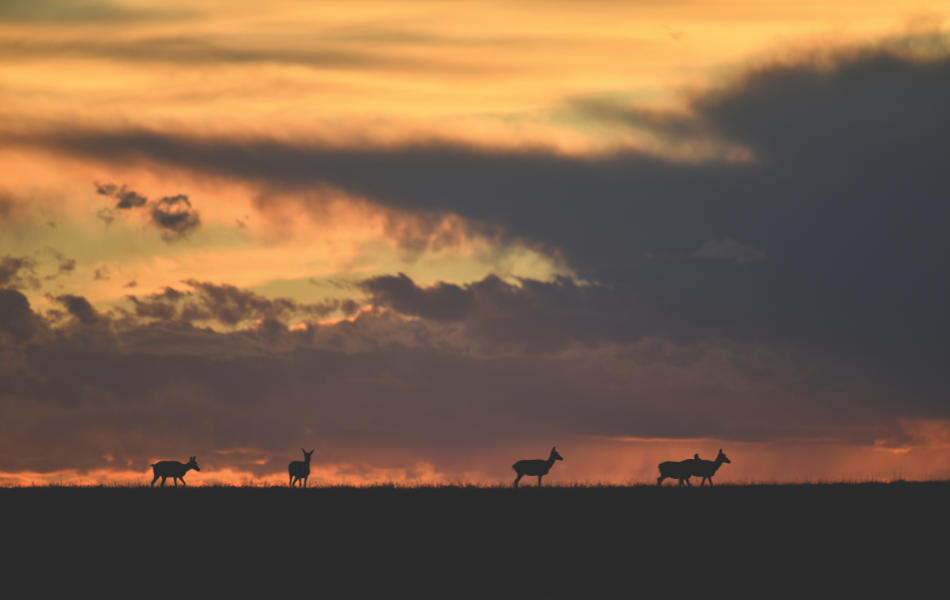
Sunset Pronghorn - Stan Harter, wildlife biologist, Lander
I would love to tell a fascinating story about how I was able to get the photo, but it was a simple case of being in the right spot at the right time. On Sept. 9, 2023, after a long day of driving around doing pronghorn classification surveys in the north end of Hunt Area 68, I headed back home along the Agate Flats Road about 25 miles northeast of Jeffrey City and I spotted this group of pronghorn does lined out along the skyline under one of the most spectacular sunsets I've seen in Wyoming. I stopped and grabbed my camera out of the back seat and started snapping some photos. This was the best of the bunch with the pronghorn perfectly silhouetted in the scene. Unfortunately, there weren't any fawns or bucks with this group, but it is a striking image, nonetheless.
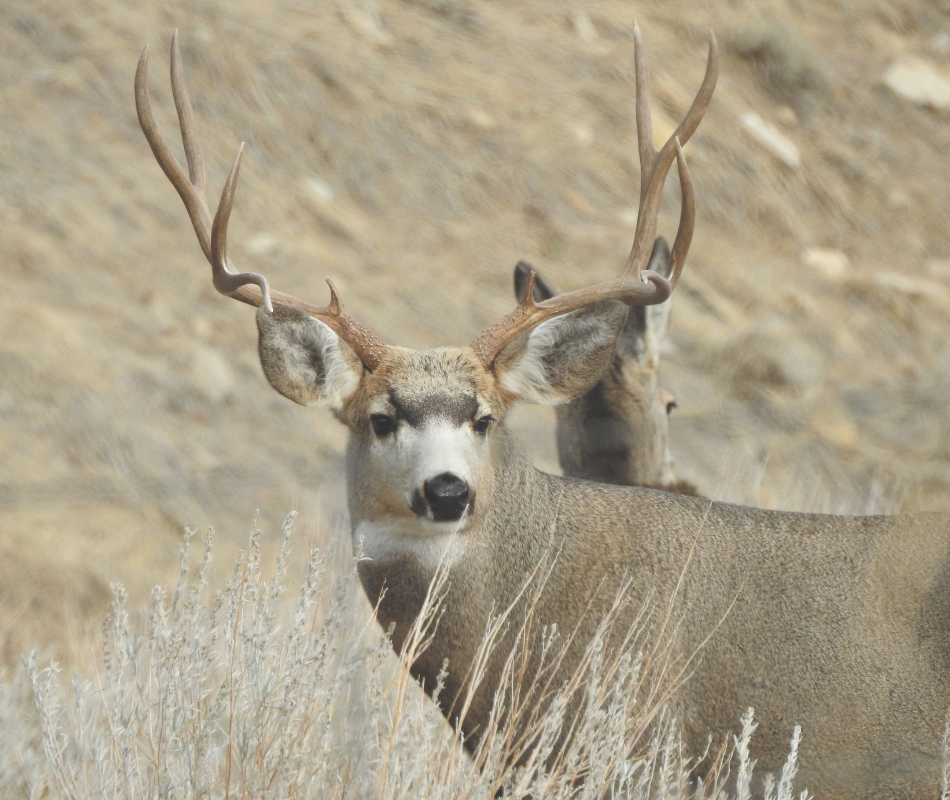
Mule Deer - Craig Swanson, habitat and access biologist, Cody
In early November I was on my way to Sunlight Wildlife Habitat Management Area for a work-related task. The mule deer were already on winter range and the rut was just beginning. While I was in my vehicle, I suddenly came across this buck. I am an opportunistic photographer, and almost always have a camera with me at work or during my personal time. I was only able to get a handful of pictures before a doe led this buck over a hill. This is an area I frequent for work and during personal time. There is always potential to see nice bucks, and also some nice bull elk. We all like to find big bucks and bulls when out in the field. Obviously, you have to be observant with chance opportunities like this buck. You generally don't have long to get pictures, especially when subjects like this are facing you.
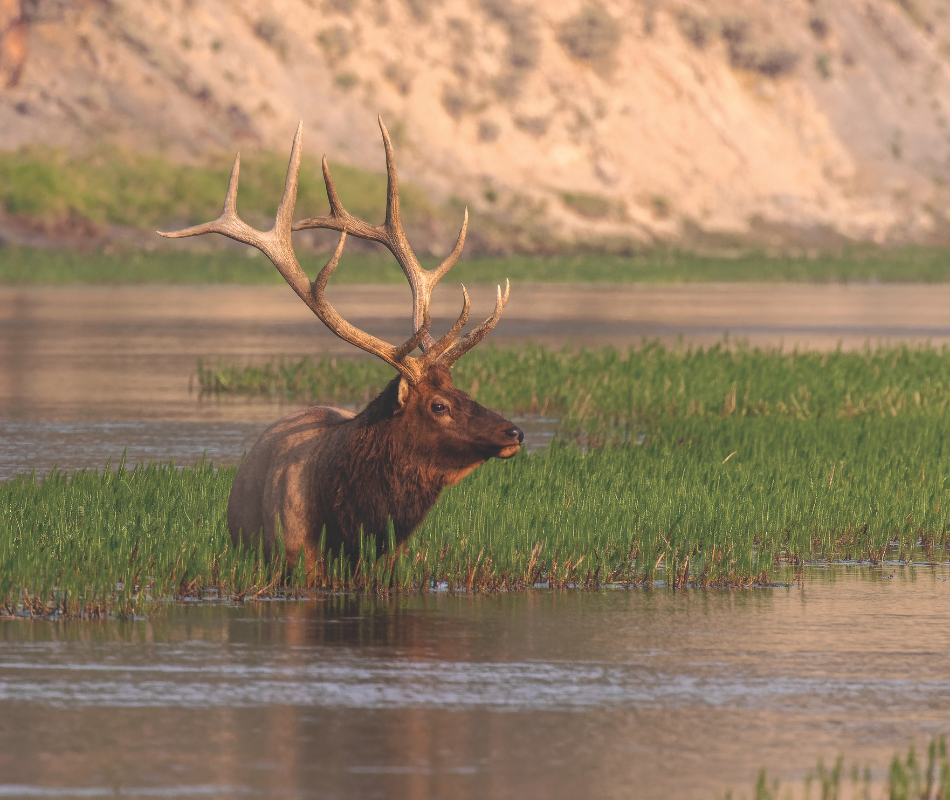
Yellowstone Elk - Mark Nelson, chief of planning and special projects, Cheyenne
In the early fall of 2021 my late wife, Mari, and I were enjoying the beauty of Yellowstone National Park and were grateful for the relatively sparse crowds as school was in session. The warm evening matched the warmth of the light cast from the setting sun. It was the magical golden hour — the short window of time when rays from the sun soften harsh landscapes and bring natural radiance to wildlife. As fortune would have it, we found this fine 6-by-6 bull elk enjoying the cooling waters of the Lewis River. Belly deep in water, the lush vegetation was an easy bite away. The elk was awash in that special, golden light. His body and impressive rack seemed to glow from within. I captured this image from a respectable distance with a powerful telephoto lens, leaving the elk to enjoy his evening in peace.
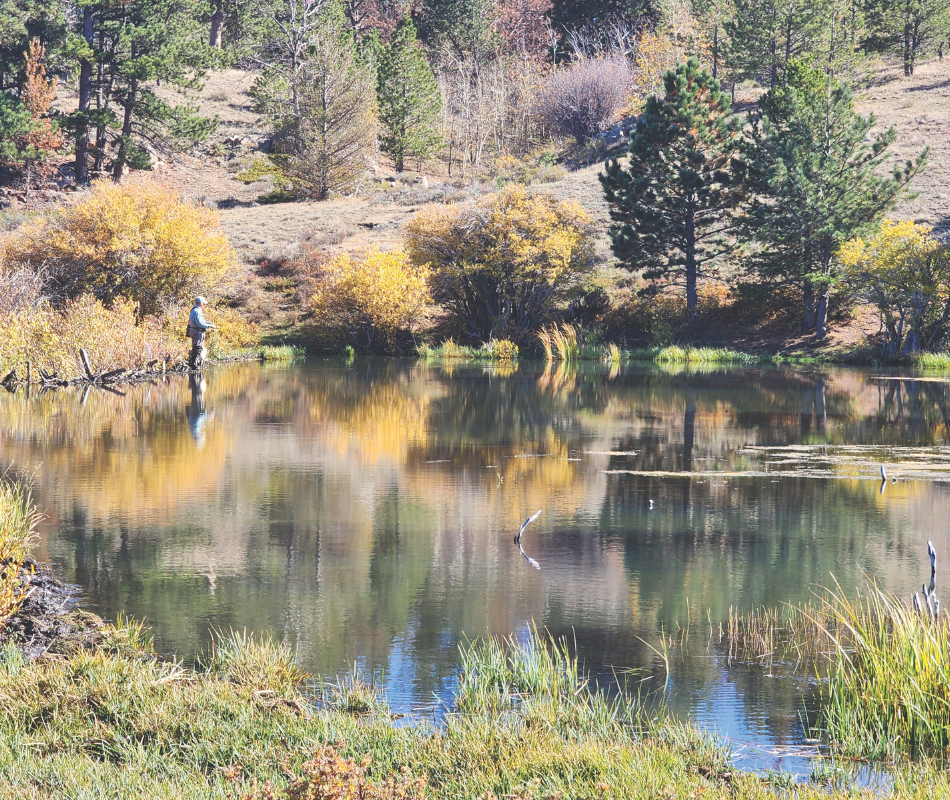
Fall Fishing - Robert Gagliardi, Wyoming Wildlife magazine associate editor, Cheyenne
There is a lot to love about fall fishing in Wyoming — cooler weather, the changing of colors among the foliage and the potential to catch some quality fish. This fall day a couple of years ago in southeast Wyoming epitomized all of those qualities. I was at one of my favorite beaver ponds in the Pole Mountain area, and a few cold days and nights killed a lot of moss and weeds that grew in the ponds during the summer.
Getting into position to fish this pond was a challenge due to some thick willows and swampy ground, but it was a lot easier to get to the right spot to capture this photo. Days like this make you wish fall would last forever in Wyoming. Unfortunately, that’s not the case, but it is fortunate when you take advantage of some premier conditions, along with some good fishing.
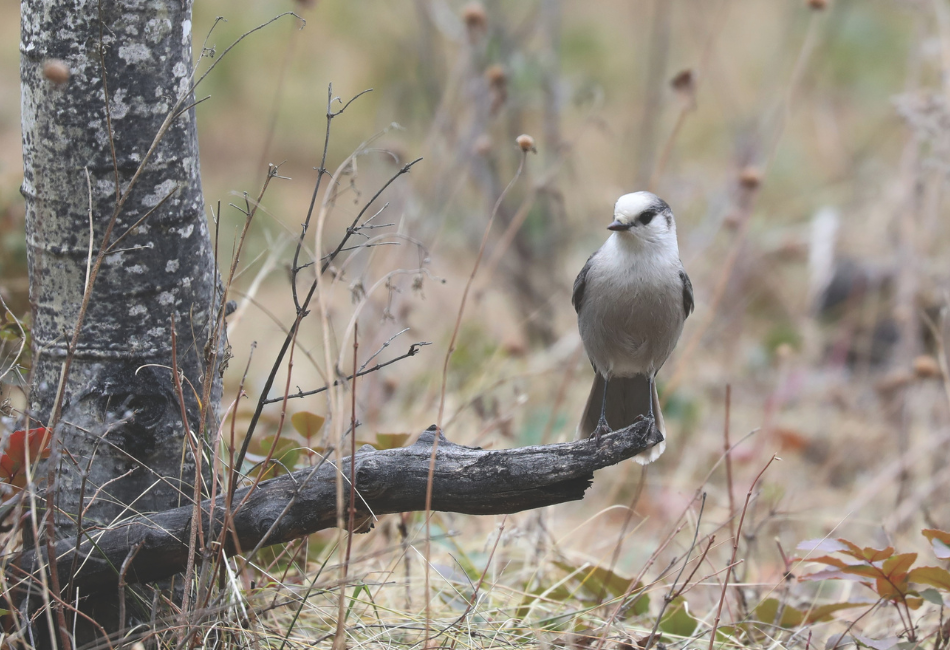
Canada Jay - Grant Frost, senior wildlife biologist, Cheyenne
I was in the Black Hills deer hunting in 2021. While driving down a U.S. Forest Service road, I noticed a Canada jay flying by. I hadn't seen many birds on the trip, so I stopped to check the area out. After I got out I heard several jays calling a short distance away. When I got close enough, I realized the jays were attracted to the remains of a deer. They would get scraps off the offal, fly off a short way and return for more. When returning to the site, they had a few perches they seemed to prefer to land on, survey the situation and finish their return to the carcass. Instead of trying to track all the different birds flying around, I focused on a couple of these perches and took pictures as they came in. I knew these birds as camp robbers when I was a kid camping with my parents. They are charismatic, and the cloudiness of the day created a nice effect to show off their subtle colors and bold characters.
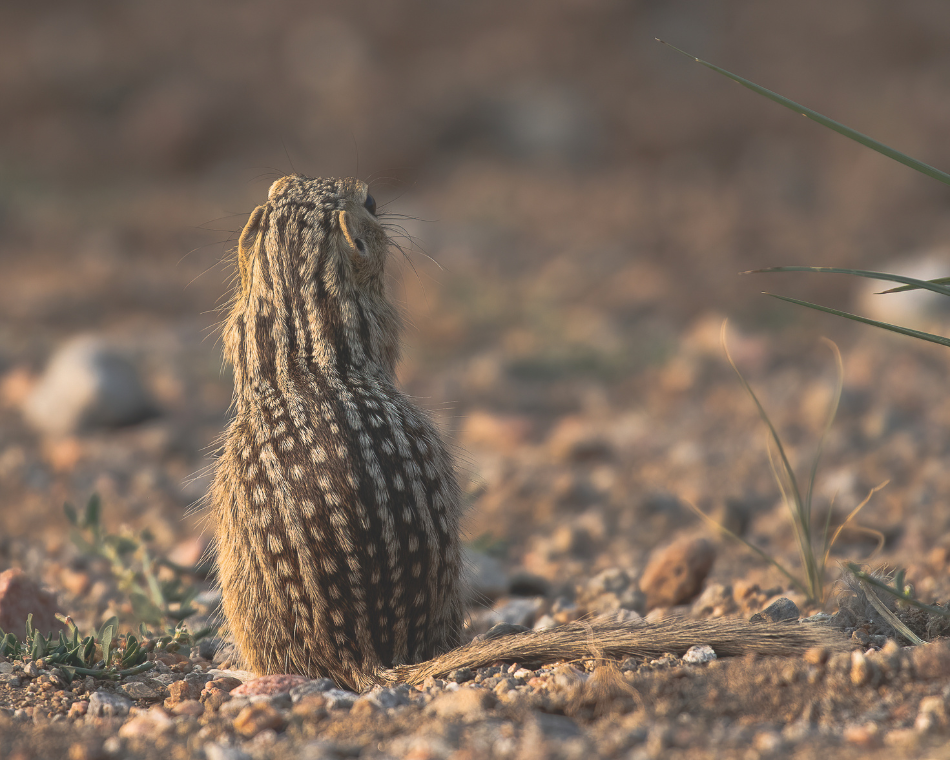
Thirteen-Lined Ground Squirrel - Mark Nelson, chief of planning and special projects, Cheyenne
I estimated the temperature inside my pronghorn blind near Chugwater was in the upper 90s, if not 100 degrees. The dry, crackling sounds of grasshoppers seemed to add to the nearly unbearable heat. My recurve bow stood propped in one corner of the blind. I packed in my camera in hopes of getting some photographs of a pronghorn coming into the waterhole I was near. While no pronghorn showed that day, I spent the time watching and photographing red-tailed and ferruginous hawks as they soared high overhead and observed the lower-flying northern harriers as they searched for a meal. Timid Wyoming ground squirrels would appear and then dash for safety as one of the raptors flew overhead.
As the day cooled, a thirteen-lined ground squirrel emerged and began feeding on seeds from weeds scattered near the waterhole. Fitting, I thought, as its genus name Spermophilus is Latin for “seed lovers.” I was pleased when I took a photo of the ground squirrel bathed in the evening’s golden light. Not only did the Latin name make sense, but the photo captured why the common name of this little fellow is the thirteen-lined ground squirrel. I counted it a successful day in my ground blind.
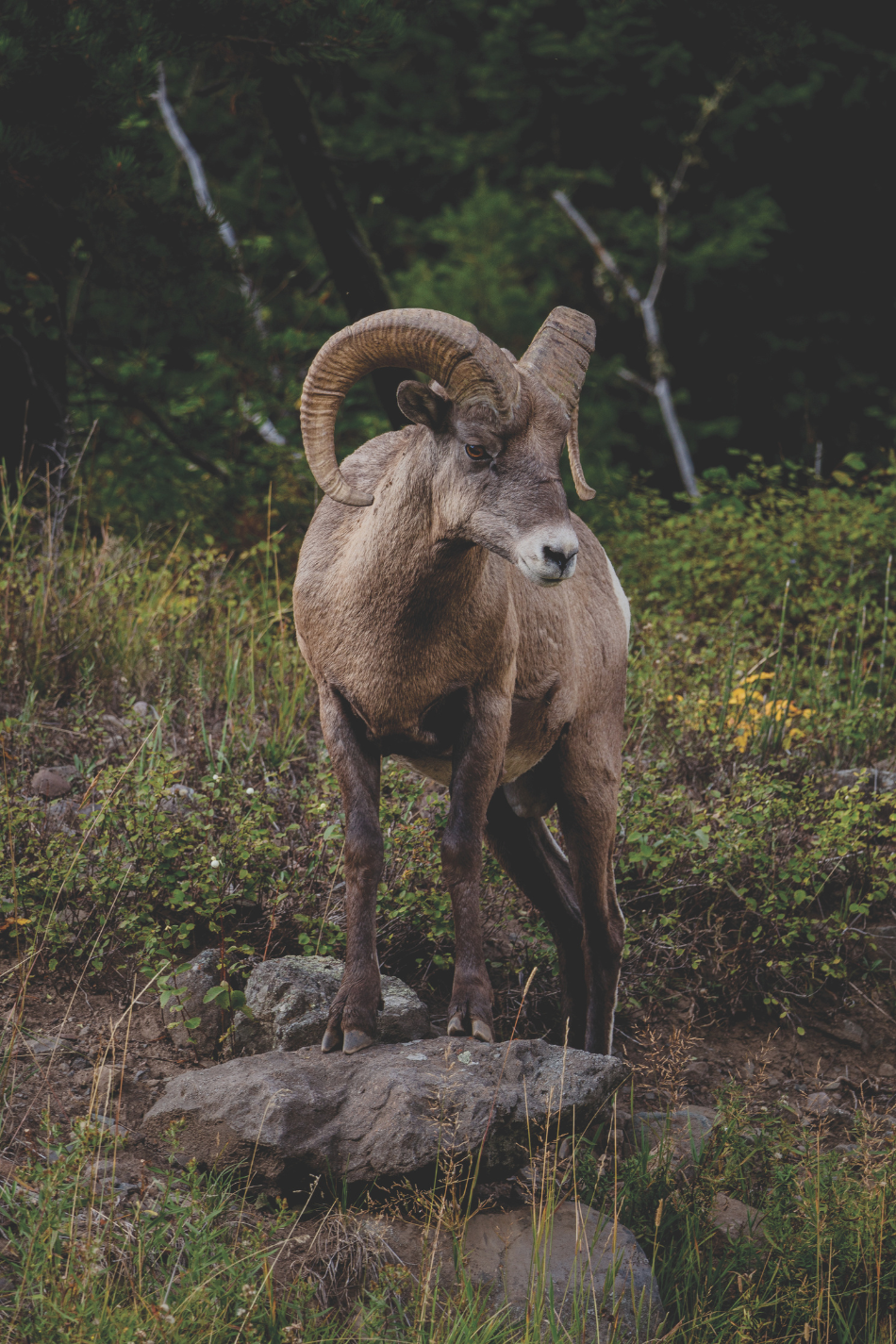
Bighorn Sheep - Emalee Smith, marketing/media specialist, Cheyenne
I took this photo at Yellowstone National Park on a September evening last year. It was my first visit to the park, and I was with my family. As I turned a corner, I came across a group of bighorn sheep calmly grazing by the side of the road. We parked the car carefully on the opposite side and watched the animals as they enjoyed their meal.
Among the group, the ram in the picture was standing proudly on a rock. I observed as it turned its head from side to side and took the photo when its posture created a well-balanced picture. The way the light highlighted its form against the dark, contrasting background made for a visually compelling image. The interplay of light and shadow directs the viewer's attention to the ram.
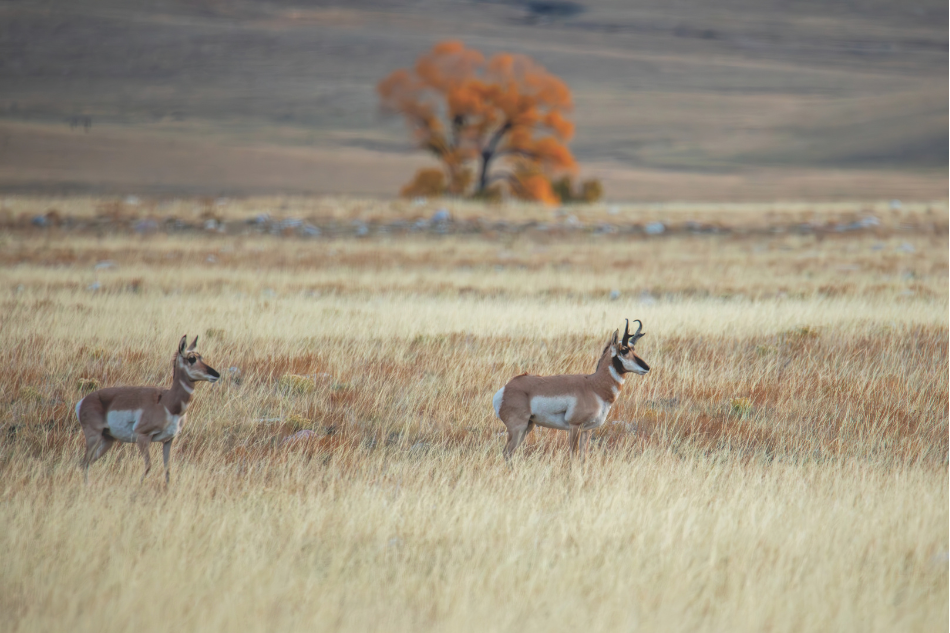
Fall Pronghorn - Stephanie Estell, statewide information specialist, Cheyenne
In a way this photo happened by accident. Two coworkers and I were headed to the Snowy Range Mountains to take photos. When we were between Laramie and Centennial, we spotted a small herd of pronghorn relatively close to the road, and we decided to take advantage. Luckily, the herd stopped in front of one of the only nearby trees, which was bursting with color during that first week of October. There wasn’t much traffic along the road so we were able to take our time setting up shots. The striations of the grass lined up just right with the pronghorn, creating a perfect frame within the frame. I was glad to have the chance to watch this buck and doe in the soft, early-morning light, and glad we took the time to stop and appreciate one of Wyoming’s most remarkable animals.
Written by Game and Fish Staff

